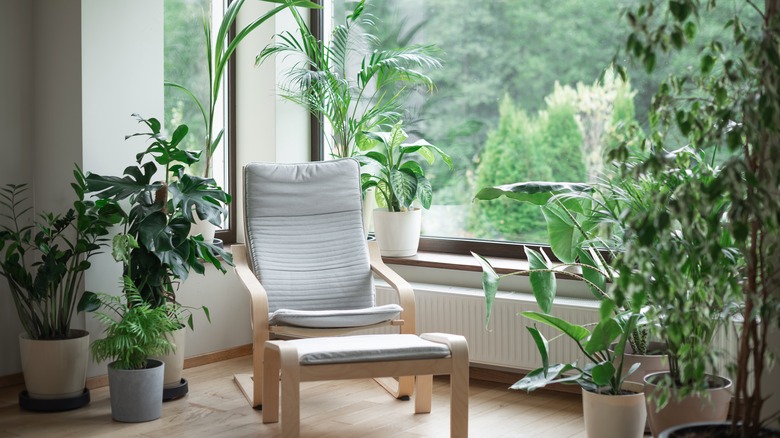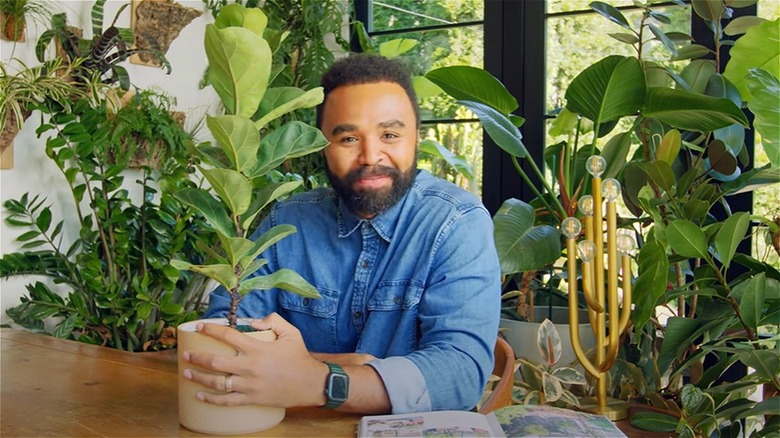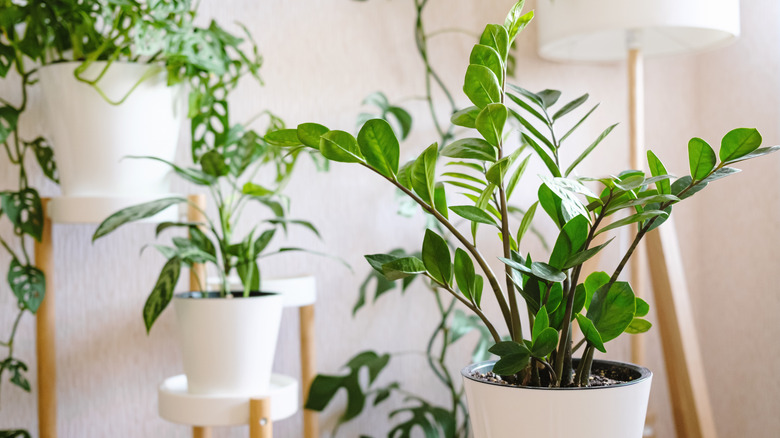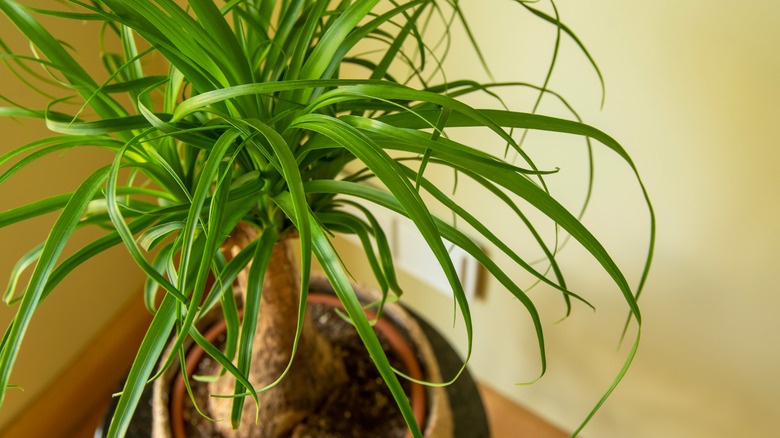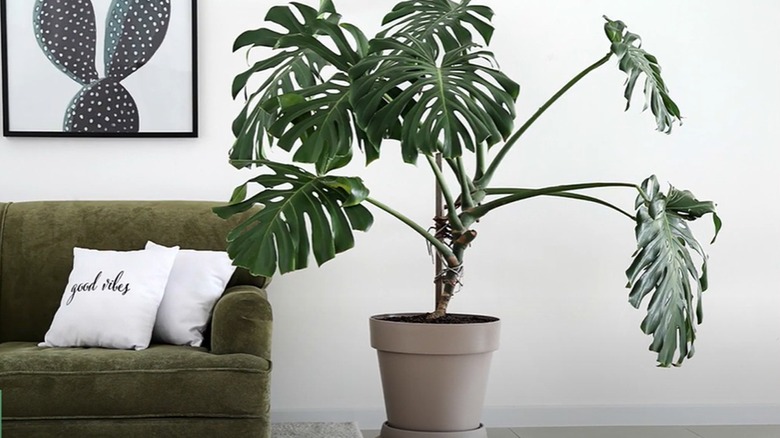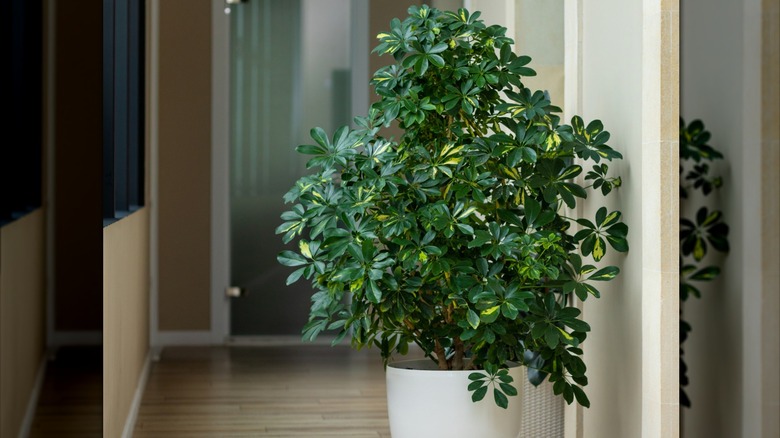The Statement Plants Hilton Carter Swears By To Style A Living Room
When it comes to styling a living room with some greenery, there are a few plants that stand out to interior stylist Hilton Carter. Known for his skills in decorating with abundant plant life, the Baltimore native loves utilizing plants to set the tone for a room. While many of Carter's home's rooms may resemble an eclectic botanical garden, the living room is his favorite space to showcase greenery. On his Instagram, Carter explained that the living room is a great place to decorate with large, bold plants and emphasized their relaxing properties, saying, "There is no better way to bring about a sense of calm than being surrounded by plants."
Initially inspired by his tall fiddle-leaf fig tree known as "Frank," Carter uses statement plants to transform a room. Whatever the layout of your space, a statuesque potted plant can own the design – whether it be set near a couch, used to fill a vast corner, or placed on a windowsill. Casual, formal, or somewhere in between, there's a myriad of sizable plants that Carter recommends for styling a living room.
Fig trees
While the fiddle-leaf fig was Hilton Carter's starting point for plant styling, he now says he would choose any Ficus tree to adorn a living room. As he puts it on Instagram, "They create the perfect vibe." These types of trees (Ficus') are common indoor plants that feature abundant greenery. With over 800 varieties, you'll be spoiled for choice, but some of Carter's favorites are the elegant audrey and the leafy benjamina (or weeping fig). For a natural focal point, position your tree on the floor between furniture or in a bare corner of the room. The plant's verdant color will pop against neutral walls and white, brown, and gray furnishings.
Ficus trees are fairly low-maintenance, but they do require the right amount of water and light to survive indoors. Depending on the type of tree, centralize your potted plant in front of a living room window so that it can receive bright, indirect sunlight. If it looks yellow, move it back to an opposite corner or against the main wall for a similar vantage. You can also decorate with these trees on various levels. "By putting plants in all areas of your eyesight, you feel completely submerged in plants," Carter says (via Patch). Climbing fig and creeping fig are lovely varieties to hang from the nook of a window, suspend from a ceiling, or let drape down from a bookshelf.
The ZZ plant
Native to Africa, the ZZ plant (Zamioculcas zamiifolia) is high on Hilton Carter's list of statement plants to style with. Known for its rich, waxy leaves, the tropical perennial is versatile when it comes to livening up a space. On Instagram, Carter says, "This lower light tolerant beauty fits in any room, but when you sit one in the corner of the room, it just instantly lifts the space to the next level." The ZZ plant likes bright, natural light and is relatively easy to care for. However, prolonged direct sunlight may lead to yellowing and deterioration. The zanzibar gem can also grow in shadier areas with minimal fluorescent lighting.
You can take your ZZ plants to new heights by providing them with various levels of sufficient sunlight. "The more light they get, the more upright their foliage will be," says the stylist (via Instagram). Like Carter's dynamic style, you could elevate a short, bushy plant by situating it on top of an accent table, credenza, or window ledge. You could also highlight one in a chic white or black planter set in a spacious spot. If you prefer your stems to bend over the pot, limit the light with curtains or shades or move it further away from the window on the floor. While Carter likes to let his ZZ's mingle with an array of other tropical plants, lush, gem-like leaves will flourish in primary or secondary light.
Ponytail palm
Another one of Hilton Carter's top living room plants is the ponytail palm or elephant's foot (Beaucarnea recurvata). Not actually a palm, this unique evergreen plant is rather low-maintenance, although it loves to soak up the sun. Carter says, "You'll need plenty of light for this one, but it's a good one!" (via Instagram). With a thick, root-like trunk and free-flowing branches, the ponytail palm easily draws attention to itself in many sun-filled locations. Because it loves direct sunlight over indirect light, it's ideal to place your potted ponytail near vast, exposed windows. Placing your growing plant within the corner of large casement or floor-to-ceiling windows would benefit dual sides of the plant.
With its wild and carefree vibe, the ponytail palm may blend well with a variety of interior styles. Ponytails can let their hair down in a raised planter within sunny areas of a living room. On the other hand, they might attract a crowd while centered on a glass coffee table or pedestal. When mixing with colors, the plant's ample green strands would contrast well against an all-white, minimalist design. Additionally, a vibrant, tropical, or pastel motif would complement its whimsical greenery. While indoor ponytail palms grow gradually indoors, you may change up their style over time. For instance, you could trim it into a unique bonsai shape.
Swiss cheese plant
With about 300 plants growing in Hilton Carter's Baltimore home, the plant enthusiast loves the majestic presence of the swiss cheese plant (Monstera deliciosa). Known for its dense green color and distinctive fenestrations, the tropical plant can instantly transform a space as an indoor houseplant. "The plant is just a tropical vibe setter," he explains (via Instagram). Originating in the rainforests of Central America, the ornamental plant may stand tall or broad when grown indoors. Unable to hide, the swiss cheese plant may reach up to 8 feet tall and 3 feet wide indoors while soaking in a full day's indirect rays.
While this tall variety is captivating on its own, variegated types are also a stylish way to add contrasting color to a living room. "If you do have an albo or thai, it's an instant statement piece," Carter continues (via Instagram). Transcend your living area into a private oasis amidst these dynamic green/white and green/cream types. If your Monstera deliciosa plant is thriving, it may become top-heavy and require a sturdier pot. Consider a sizable one made of clay, concrete, or terracotta while establishing a hardy, rustic look. If your plant is young or on the small side, you might use a plastic, well-draining container to start out. Whichever swiss cheese plant you choose to style with, it will be a winner.
Umbrella plant
For a big green statement, there is no other plant like the umbrella plant (Schefflera). An exquisite flowering variety, this type features a tall physique and charming leaflets that Hilton Carter adores. An abundance of diverse green and yellow umbrella plant shrubs may often be seen within the landscaping of South Florida. However, this plant thrives well indoors in vibrant, filtered sunlight. While this variety may grow over 10 feet indoors, there's a dwarf type that won't grow as tall. With its diverse shapes and sizes, the umbrella plant offers an assortment of options when styled within a living room.
Carter isn't afraid to display full-size plants in extra large belly planters. "I'd bring this [extra large] planter inside and sit it to the side of a couch or console table," he explains (via CB2). A slender, full-sized plant would also emanate the tropics in a woven rattan basket when placed near French doors or windows. Small-to-medium potted umbrella plants may also mingle among other greenery and furniture. Keep it conversational and set one on a side table or stool between arm chairs. Give a smaller potted plant more height by placing it on a mantle or another platform. Wherever you place your star Schefflera, it's sure to make an impression.
